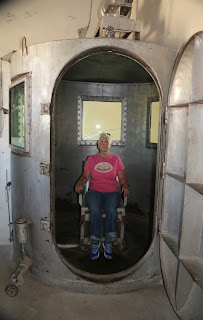 |
| Once in, you can't always count on getting out. |
 |
| The stone is unusual to me, not the regular brick and I'm sure it's pretty thick, too. |
There were train robbers, murderers, those who escaped and those who got
caught and returned. That included one
who assaulted a woman who was exceedingly nice to the inmates. This guy escaped and was recaptured, and put
back into Old Pen to keep him from possibly being lynched by the community
members. Bad luck for him. The inmates got the jailers and put them in
cells. They hung the guy from the third
floor of the jail, and when he didn’t die, drug him up and pushed him off
again. He died that time. Then they let the jailers out of the cells
and went about their business. No one
would own up to killing the guy so he was left hanging throughout breakfast to
see if someone would confess. Nope. So they cut him down and that was that.
The pen opened in December of 1901, complete with 104 cells,
none of which had electricity, running water or adequate heating. The original cell block consisted of 5x7-foot
cells housing two men on bunk beds.
It was hard to imagine two men in each of these small cells
that also held a toilet and a sink. They
were allowed to paint them so there was a rainbow of colors from pastel-blues
and greens to darker colors. Most seemed
to be the lighter variety although maybe some have faded over time. Some have dabs of white, which we learned was
toothpaste and used to glue photos to the walls.
Thirty-two additional cells were built in 1904 due to
overcrowding, and there was even a dungeon-house for the true incorrigibles. Still more cells were built a couple more
times, including in 1966.
There were women housed here but it was too difficult to
keep them, and so they were transferred to other jails. The last one to be transferred out was the
Poison Plum Killer, Annie Bruce, who it is said killed her father by preparing
him a special plum pie, laced with poison.
 |
| The third level up was not the place you'd want to be tossed from. |
 |
| There's not much room for one person, much less two. |
 |
| I don't think I'd want to use these facilities. Don't do the crime, you won't do the time. |
 |
| Wall art was forbidden; however, in the upper tier cells, on the dark ends, sometimes there was art that wasn't found by the guards. This was a self-portrait. |
 |
| This is all that is left of the dungeon cells. They were tiny so one couldn't lay down and it was solitary. A very bad place to be, in my mind. |
Some here were killed by the gas chamber that replaced the gallows in 1936. The gas chamber was tested using a pig before trying it out on the two-legged animals. Poor piggy.
 |
| It wasn't a good feeling sitting in that chair. |
 |
| All metal doesn't make for a comfortable chair, even if you do know you're going to be gassed. |
 |
| This is a replica of the real thing. The floor drops, and you're hung. Pretty plain and simple workings. |
 |
| We wandered out to the yard, and these are the guard towers located in all of the corners. |



No comments:
Post a Comment